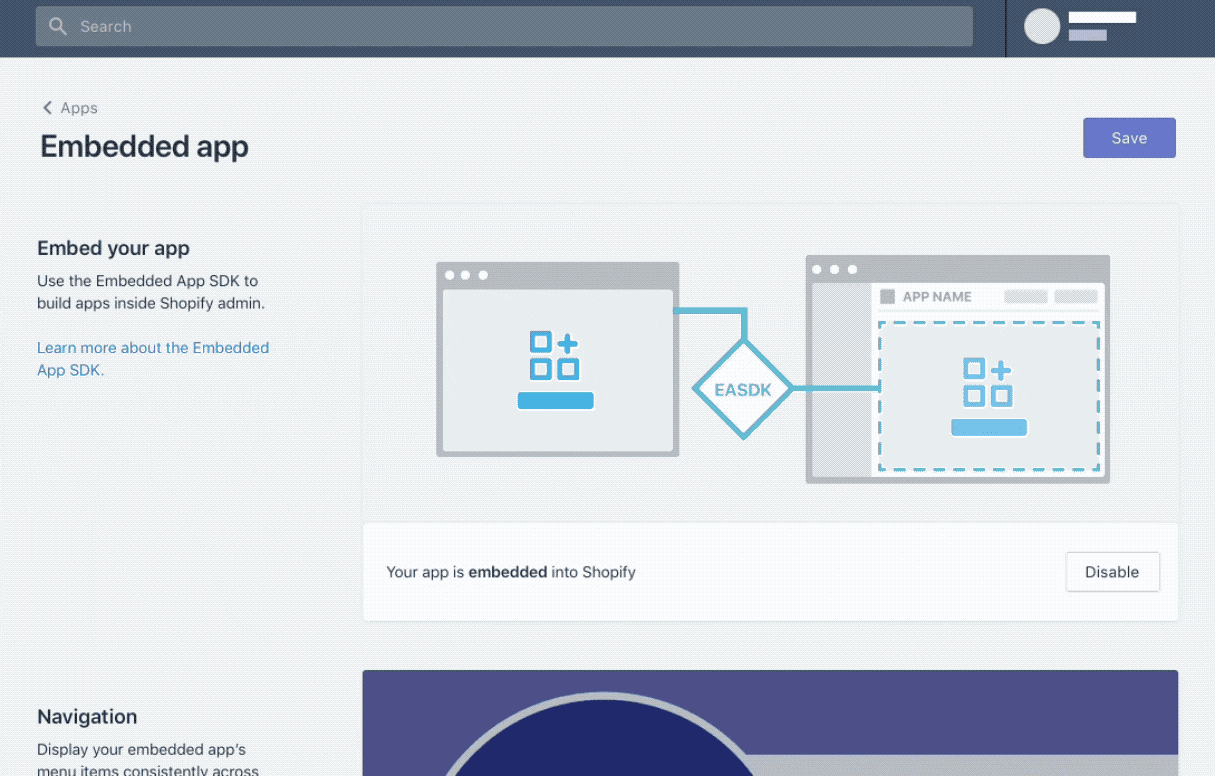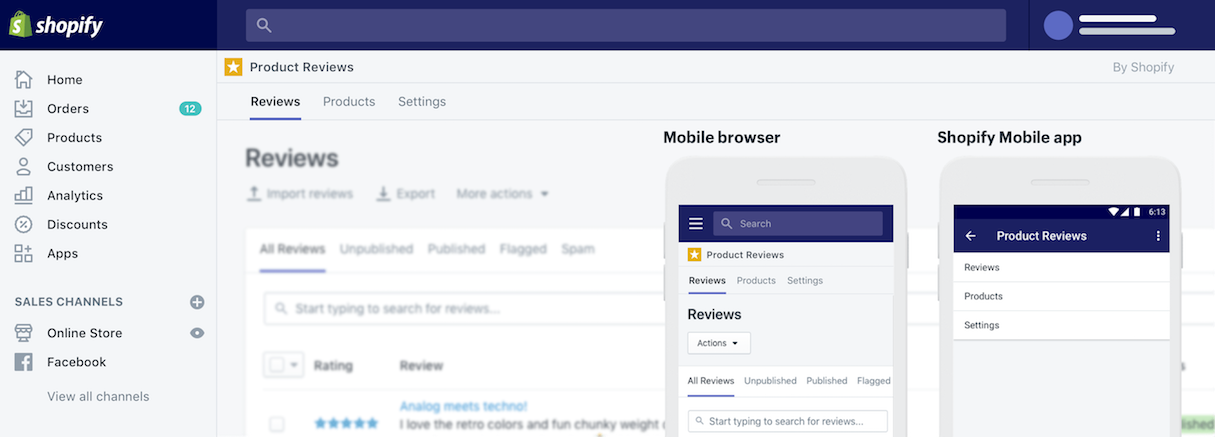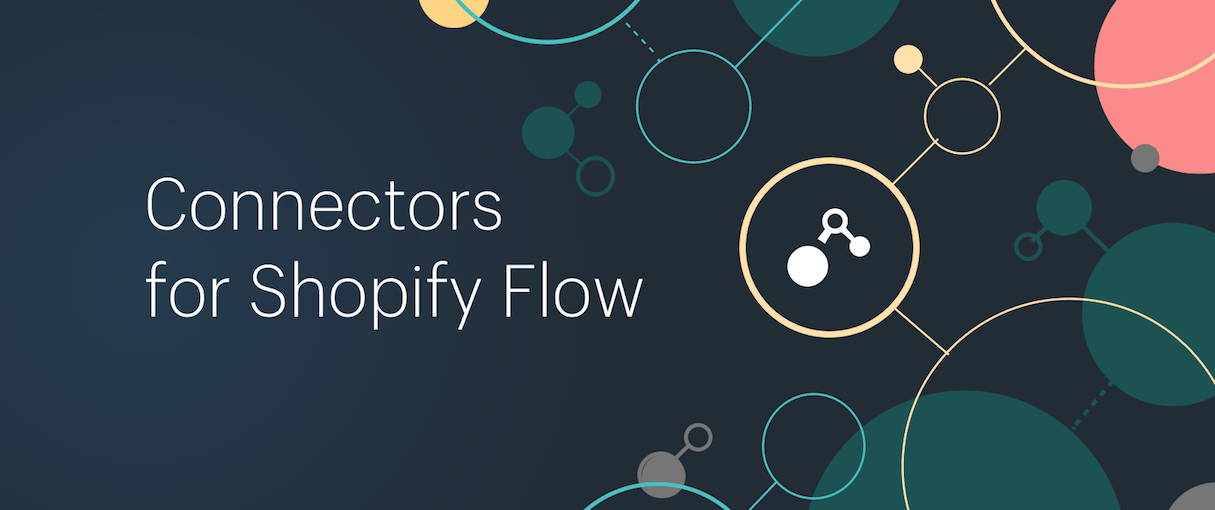Over the past year at Shopify, we’ve seen tremendous growth. With over 600,000 merchants on our commerce platform, we’re working to power more entrepreneurs than ever before.
As this number grows, we want Shopify Partners to be empowered to scale their businesses along with ours . This means providing new updates and tools to help you expand and adapt your offering, to keep-up with the ever-changing demands and expectations of merchants.
. This means providing new updates and tools to help you expand and adapt your offering, to keep-up with the ever-changing demands and expectations of merchants.
With all this in mind, we’ve improved some of the tools you’ve come to know and love, and released new products and features, designed to help you reach more merchants and offer new services.
Read on to get an overview of the improvements and additions announced at Unite 2018.
You might also like: Build Better Apps Faster with the New Admin API in GraphQL.
The new EASDK and navigation extension
Most of our top app developers are very familiar with the EASDK, which enables all apps and channels to be embedded directly into the Shopify Admin.
This gives merchants the best possible user experience across desktop, mobile, and point-of-sale (POS). To make the embedded app experience even better for the developers who use this tool, and for the merchants who experience the output, we’ve made some exciting changes and additions.
If you already have the EASDK implemented, no upgrade action is required since we’ve made Shopify App Bridge (the new version of the EASDK) backwards compatible. If you’re new to Shopify App Bridge and building embedded apps, you will need to enable it in the Shopify Partner Dashboard first, and then set up the JavaScript library through the available documentation.
One of the first issues we addressed in this update is providing developers a better experience building embedded apps in the Shopify Admin. The new EASDK will include support for Redux DevTools for all apps, even if your app doesn’t use Redux.
The new tools allow developers to dispatch sample actions, inspect every state and action, and travel back in time to replay actions. The EASDK has been published on NPM using Sem Ver, meaning that Shopify can easily release or remove features, and partners are protected from regressions or failures when things change.
App identifier and navigation extension
With the new EASDK title bar, we will be launching a new app identifier and secondary navigation for embedded apps.
The new consistent app identifier allows merchants to directly identify when an embedded experience is provided by an app developer. This new navigation structure also gives you the ability to integrate into the Shopify Admin through a new responsive and native-mobile optimized navigation extension.
Currently, many app developers are using EASDK action buttons for navigation or to create custom secondary navigation because the old EASDK didn't have a dedicated navigation extension to complement your embedded app
With these new features available to you, we encourage you to take advantage of them to help cut down your development time and ensure your app navigation is consistent across platforms. Best of all, the new app identifier will be automatically set up for new and existing apps built with Shopify App Bridge, and secondary navigation can be easily configured in the partner dashboard.

Once navigation is configured, changes will be automatically reflected in the app.

The app identifier and navigation extension will be launched in the upcoming weeks alongside with the new EASDK. Developers will be able integrate more deeply with the Shopify Admin and merchants will have a consistent embedded app experience, across devices.
Stay tuned for this new release and accompanying documentation.
Help merchants better manage inventory across all their locations
This summer, we’re launching a new concept called Locations that will help solve the complexities and operational challenges our merchants face when managing inventory across multiple locations.
Merchants with multiple locations need to know exactly where their merchandise is stocked, fulfilled, and returned. They need to have the right items, at the right place, at the right time.
To support Locations, and invite our partners to help build new solutions, Shopify is releasing a new Inventory API, which includes three new resources: InventoryItem, InventoryLevel, and Location.
Some of the key benefits will include:
- Apps and merchants will be able to track and set inventory per location
- Apps and merchants will be able to specify exactly where orders are being fulfilled from and where items are being restocked
- Merchants will be able to check item quantities from other locations, right from Shopify point-of-sale (POS)
- App developers will be able utilize inventory specific webhooks
The introduction of Locations also comes with a number of changes to our existing Product and Variant, Fulfillment, and Refunds APIs. As of July 1, 2018, apps will no longer be able to use the Product and Variant API to adjust inventory. Going forward, all apps should use the Inventory API instead.
In addition, dropshipping, third-party logistics(3PLs), and print on-demand apps now have a dedicated home within Locations. By migrating to the existing Fulfillment Service APIs, you’ll be represented as a location under the locations index, and will inherit similar behaviors in the admin.
Items managed by these apps are solely stocked at that respective location, and we’re working to improve this in the future.
The future of Locations
These updates are just the beginning of what Locations will evolve into. Among many other improvements, this year we’re focusing on:
- Improving our order routing logic. We want to provide merchants and apps with more flexibility on how and where orders are being fulfilled.
- Building embedded workflows for fulfillment apps right within Shopify.
- Improve order fulfillment responsibilities, so we can specify who should be fulfilling specific items on an order.
Locations has been heavily requested by our merchants, and we’re excited to empower you, our partners, to help create solutions that save merchants time, so they can instead focus on growing their businesses.
You can now help merchants using Shopify operate their entire business, in a reliable and consistent way. And for merchants already using Shopify, expansion just became a whole lot easier.
Locations is set to launch Summer 2018, and our new Inventory API is available now. For details on API changes related to the Inventory API, please view the migration guide.
You might also like: 3 New Ways to Entice and Engage App Users—Marketing Activities App Extension, Ping, and Kit Skills.
Better ways to help merchants offer discounts, using the BOGO type feature and Discounts Applications API
Last year at Unite, we announced the Price Rules API to allow app developers to create discounts of all types, from free shipping, to percentage based, to customer specific discount. Since launch, over 240 million price rules were created through this API, helping more than 600,000 merchants make more sales.
This year, we’re making creating and offering discounts even easier, with two new product releases.
Help merchants offer buy-one-get-one discounts
We're excited to announce the addition of one of the most popular types of discounts for both merchants and buyers alike: BOGO (buy one, get one). Using the Price Rules API, you can now create BOGO type discounts, such as "Buy one, get one", "Buy one, get 50%", "Buy 3, get 2 for free", or "Buy a shirt, get a t-shirt for free."
This update is currently being rolled out, and will be available to all by mid-May, 2018.
Know where and how discounts were applied with the new Discounts Applications API
The Discount Applications API is a new interface that shows how discounts are calculated and applied across line items and shipping lines.
Going forward, Shopify will automatically expose discount applications in our Orders REST API, and our new GraphQL Admin API. The former (legacy) Applied Discounts API will exist simultaneously until we ultimately phase out legacy behavior.
This improvement will make offering discounts and reporting on them, easier than ever.
Improve UX for your translated apps with Locale Param
We know that some Shopify app developers who serve global merchants have gone through the process of translating their app into multiple languages.
With Shopify enabling select merchants to view the Shopify Admin in Japanese, German, or French, developers who want to translate their app into these languages now have a way to make the user experience even smoother.
With the locale param your app can detect which language the merchant prefers and automatically surface the app in that language.

This param is available to start using today! Check out the documentation to learn more about translating and localizing apps.
New tools for your Shopify Plus clients
Shopify Plus provides high-growth merchants with the building blocks they need to run a successful business. We’re announcing three exciting tools sure to help your Shopify Plus clients grow and thrive.
Connectors for Shopify Flow

Since launching, Shopify Flow has automated over 150 million workflows—all with just a few clicks. Merchants have offloaded time-consuming tasks and built creative new processes using Flow’s visual workflow builder, as well as its trigger, condition, and action logic.
Merchants have also used Flow to automate workflows that start and end from events and actions within their Shopify store—but we know that in today’s world, an ecosystem of apps and technologies keep businesses running.
That’s why we’re announcing connectors for Shopify Flow.
Now, you can use Flow’s automation platform to help merchants connect the complex web of tools and services they use everyday to run their businesses. Building a connector allows merchants to start a workflow from an event within your app; you can allow simple or complex conditions that determine if the workflow should run, and you can end it with an action within your app.
and services they use everyday to run their businesses. Building a connector allows merchants to start a workflow from an event within your app; you can allow simple or complex conditions that determine if the workflow should run, and you can end it with an action within your app.
Connectors are created using app extensions, so you can easily build triggers and actions, and enable them for merchants already using your app. In just a few hours and with minimal investment, connectors position you to link your product to enterprise businesses and technologies around the world, without working with each partner’s API separately. You’ll surface more of your solution into the platform merchants interact with daily in order to operate their businesses.
Connectors give your app instant access to the power of automation. Even better, the workflows resulting from connectors can use both Shopify and partner app data to execute powerful ideas and tasks—all without scaling server capacity during spikes in volume. Help merchants creatively link your app to both Shopify and other third-party business tools, bridging connections and use cases that previously weren’t possible.
Start building connectors for Shopify Flow today.
Shopify Flow aligns perfectly with our goal to free merchants from process, so they can concentrate on innovation and delighting shoppers. By applying a unique combination of triggers, conditions, and actions developed for Shopify Flow, merchants can experiment with thousands of innovative ways of using LoyaltyLion and our third-party partners to maximize customer engagement and retention.
Multi-currency for Shopify Payments

With the announcement of Multi-currency for Shopify Payments, you will soon be able to help merchants grow globally by acting locally.
Multi-currency for Shopify Payments allows Shopify Plus merchants to sell in local currencies —including AUD, EUR, JPY, SGD, USD, CAD, HKD, NZD, and GBP—and settle in their preferred one. It positions brands to offer customer-friendly international storefronts and checkout experiences—all managed from one Shopify store.
—including AUD, EUR, JPY, SGD, USD, CAD, HKD, NZD, and GBP—and settle in their preferred one. It positions brands to offer customer-friendly international storefronts and checkout experiences—all managed from one Shopify store.
In addition, it enables merchants to quickly add or remove local currencies as markets change, helping them experiment with growth country-by-country. The automatic storefront currency capabilities, complete with powerful geolocation functionality, will allow your clients the ability to show local currency prices, based on current foreign exchange rates that are rounded for stability.
From product creation to payout reconciliation, Shopify’s multi-currency for Shopify Payments provides a consistent experience, so merchants can sell internationally with confidence.
Stay tuned, multi-currency checkout is coming Fall 2018 starting with Shopify Plus merchants on Shopify Payments and eventually rolling out to all merchants. We’ll be looking at adding more currencies soon.
You might also like: 3 Ways We're Helping Shopify Partners Build Better Businesses in 2018.
Transporter

Transporter is a new data migration solution that significantly simplifies the process of moving to Shopify Plus. Transporter puts the control in a partners hands, and enables you to offer a fast and seamless ecommerce migration experience, positioning you to own the entire merchant experience, from migration to launch.
Instead of building your own migrations tools or working with third-party services, you can now focus on launch strategies and innovations. And instead of dealing with uncooperative data, tool maintenance, or hosting costs, you can now use Shopify’s server scale, capacity, and speed, so you can be confident in offering clients a lightning quick migration experience.
Today, we’re announcing two tools to get you started:
First—Transporter’s command-line tool. We’ve open sourced this tool and provided scripts that allow you to transform legacy platform data into Shopify-friendly CSVs. If you have complex or irregular data—no problem. You can customize scripts to take you the rest of the way. We’ve provided scripts to convert Magento store data to start, with more platforms to come.
Second—use the Transporter app to load merchant information into Shopify. The app has many benefits over native CSV importing, including:
- Support for multiple objects, including orders and metafields
- Ability to upload files up to 100mb
- Runs 10 times faster than standard APIs
- Simultaneous file migrations, with full progress tracking in real-time
- Error reporting for easy troubleshooting
Begrudgingly executing time consuming migrations that erode profit margins are now relics of the past. With Transporter, you can focus on the exceptional design and development work your clients have come to expect and enjoy.
New opportunities to reach more merchants
With these new platform updates, you can build and work more efficiently than ever before, and extend your services to even more merchants. It’s now easier to provide excellent user experience, tackle complex problems, and better serve international merchants.
Read more
- What’s New at Shopify: Nov. 24, 2017
- Growing Together: A Look Back on the Shopify Partner Studio NYC
- How to Find Support as a Shopify Partner
- Announcing The Shopify Commerce Awards — Celebrating 2017’s Best in Commerce Innovation
- Introducing Shopify Community: An Enhanced Forums Experience
- What’s New at Shopify: October 27, 2017
- The Shopify Partner Program 2.0 — A Partnership You Can Build On
- What's New at Shopify: September 7, 2018
- Announcing Shopify Unite 2021: Coding Commerce, Together
Which of these new updates are you the most excited for? Tell us in the comments below!

